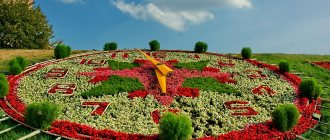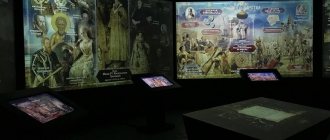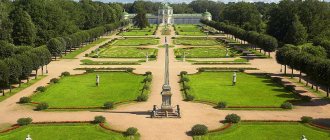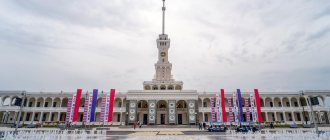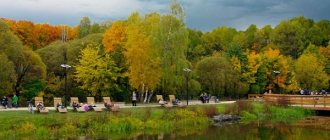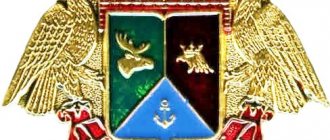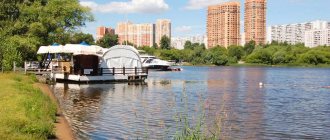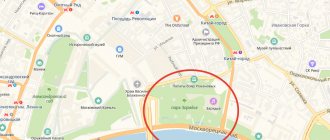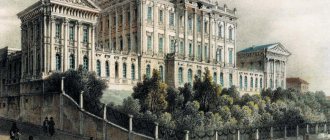Victory Park on Poklonnaya Hill in Moscow.
History of the park. Victory Park in Moscow is a memorial complex founded in 1958 in honor of the victory in the Great Patriotic War. The park, with an area of about 135 hectares, is located between Minskaya Street and Kutuzovsky Prospekt, and consists of many attractions. A small slope in Moscow was called Poklonny since the 16th century; it was from here that a panoramic view of the capital opened up. The name of the hill has several versions of its origin, which all Muscovites will tell you about.
The park originates from a granite stone engraved with the names of heroes who died in the war. The monument was erected on the slope in 1958, and three years later trees were planted around it and a park was laid out.
The main development of the park began in the 80s of the last century, and the grand opening took place on May 9, 1995. Today Victory Park is one of the largest memorial centers in the world.
Story
For several centuries, the gentle slope on which Victory Park is now located was called Poklonnaya Gora. This name was due to the fact that since the 16th century, travelers have looked at Moscow and its environs from these heights. According to one version, visiting people were so fascinated by the view of the city and the local beauty that they bowed to him and left various expensive gifts as a sign of respect. According to another version, in those days a bow was a tax levied on all non-residents; accordingly, gifts were a mandatory payment for visitors.
The idea of creating a monument to the people's feat was first expressed by the architect Yakov Chernikhov in 1942. However, wartime did not allow it to be implemented quickly. The first memorial element on the site of modern Victory Park was installed only 16 years later - in 1958. It was a commemorative granite stone with the inscription: “The monument to the Victory of the Soviet people in the Great Patriotic War of 1941–1945 will be built here.” Three years later, in 1961, trees were planted around this stone and a park was laid out. Later, the project was suspended: first due to the death of the architect, and then due to lack of funds.
In the 1970s–1980s, 194 million rubles were collected for the construction of the park (money collection was organized throughout the country, so that everyone could contribute to the construction of the iconic memorial); the remaining funds for the construction of the monument were allocated by the state and the government of Moscow. The well-known Zurab Tsereteli was entrusted with continuing the implementation of the project, and in the second half of the 1980s, work began on the construction of the complex.
The grand opening of the memorial complex and the Central Museum of the Great Patriotic War took place on May 9, 1995, on the day of the fiftieth anniversary of the Victory.
Central Museum of the Great Patriotic War, © Margarita Kushnirenko
All that does not allow you to forget
Two years later, in 1997, several more objects were added here. One of the monuments was dedicated to the defenders of Russian lands, and the other to the tragedy that the peoples experienced. In addition, a memorial mosque appeared. In 1998, the site was supplemented with a synagogue.
With the advent of a new decade, in the 2000s, the administration and authorities continued to develop the park. And in July 2001, the hill of Poklonnaya Gora was crowned with huge flower dioramas, which have practically no equal in the world. Their diameter is 10 m. There is a clock here that was launched and then registered in the Guinness Book. Their uniqueness lies in their huge size.
Museum in Victory Park on Poklonnaya Hill
The Central Museum of the Great Patriotic War is the central object of the entire memorial complex of Victory Park.
The purpose of creating the museum was to perpetuate the memory of the heroism and courage shown by Soviet soldiers during the Second World War. The museum conducts scientific, cultural and educational work, organizes events for the patriotic education of youth, and regularly holds various thematic exhibitions in its galleries and exhibition halls.
The museum exposition consists of 3 halls: Generals, Glory, Memory and Sorrow, six dioramas dedicated to the main strategic operations of the Great Patriotic War, and the “Book of Memory” department (which stores the names of millions of soldiers, as well as preserved information about their destinies).
Central Museum of the Great Patriotic War, © AMURKIN
The museum's fund has a large variety of unique items and elements of military equipment and equipment, documentary materials, as well as photographs and fine arts dedicated to the Second World War. One of the main relics of the museum is the Victory Banner - the same one that was installed above the Reichstag in Berlin on April 30, 1945.
You can walk to the museum along the main alley; in front of its building stands the Obelisk of Victory - a bronze bayonet about 141.8 meters high (the Great Patriotic War lasted 1,418 days).
Opening hours of the WWII Museum: Tuesday-Thursday, Sunday - from 10.00 to 20.30, Friday, Saturday - from 10.00 to 21.30, Monday - closed.
Excursion to the WWII Museum and Victory Park in Moscow Buy at
Front foyer of the Central Museum of the Great Patriotic War, © Margarita Kushnirenko
Military equipment
The museum's exposition continues outdoors in Victory Park, where a unique exhibition of military equipment and engineering and fortification structures is displayed. Here you can find more than 300 samples of heavy equipment from both the Soviet Union and other countries of the anti-Hitler coalition, as well as Germany and its allies.
Among the exhibits at the exhibition are artillery installations, aircraft models recreated with maximum accuracy, a reconstruction of a machine-gun bunker, several tanks, including the legendary T-34. But the exhibition is not limited only to ground-based equipment: for example, an artificial reservoir was specially created for exhibits of naval armament, on the territory of which huge models of ships are located, and along the banks there are artillery ship towers, torpedoes and other guns.
On another site of the exhibition park is Partizanskaya Polyana. Unique structures have been recreated here - soldiers' dugouts, a front-line command post, an observation tower, and trenches used by partisans during the war.
Beauty requires... attention
The Victory Monument, located in front of the entrance to the museum, is unmistakably recognizable: the silhouette of the equestrian statue of St. George the Victorious, bas-reliefs dedicated to the Belarusian operation, the Battles of Stalingrad and Kursk, gilded names of hero cities. But the most interesting thing is the stele.
It is made in the form of a bayonet. The architects took the shape of a Russian rifle from 1898 as a model. The thousand-ton obelisk is a steel trihedron; for a stele of such height, this is an unusual and difficult shape to implement. To correctly calculate the loads, the designers blew the mock-up of the structure in a wind tunnel.
To partially neutralize the wind load, a system of dynamic vibration dampers was installed on the stele. The damper copes with the strongest ones at around 110–113 meters. The structure, with an inertial mass of 10 tons, oscillates in antiphase to the tower, preventing it from swinging much. This damper and two other similar structures are responsible for vibrations of the first tone, and 15 more help prevent vibrations of the second tone - with a small amplitude but a high frequency.
The decorative elements made the designers’ task even more difficult: at a height of 104 meters, a bronze statue of the goddess of victory, Nike, weighing 25 tons, was installed on the stele. She holds a wreath in her hands, and on either side of her two angels trumpet about the exploits of Soviet soldiers. According to Salkarbek Shamkanov, if it were not for the statue, it would have been easier to calculate the wind load coefficient on the structure. But the engineers figured out how it could help: a torsional vibration damper was installed inside the sculptural group, and the main bending vibration damper was installed behind Nika’s shoulders.
The amplitude of the stele’s vibrations is monitored around the clock: a center for monitoring the condition of the structure has been set up in special rooms under the monument. An engineering and production group works here - four duty shifts, each with two engineers.
On the system’s monitors there are indicators of vibrations with visualization of the structure and meteorological data: wind speed, its direction, air temperature - the amplitude of the vibrations also depends on it, so it is important to take into account even which side the sun illuminates the obelisk. On other monitors there are images from surveillance cameras, which allow you to examine the details of the monument, including the sculptural group.
Online monitoring of the structure is not the only thing that the stele’s guardians do. Specialists regularly inspect the structures: using a lift they climb onto platforms installed inside the obelisk every 12 meters and check the condition of the metal structures. True, the lift cannot reach the very top - engineers can only climb to the several upper platforms using vertical stairs with special insurance.
Events in Victory Park in Moscow
Victory Park on Poklonnaya Hill is one of the favorite places for recreation for both Muscovites and guests of the capital, as well as for holding various festive and sporting events, festivals, concerts and public celebrations. The beautiful landscapes of the park are intertwined with the solemn atmosphere of the majestic memorial and fascinate visitors with its beauty and splendor.
Temple of St. George the Victorious and Victory Monument, ©
May 9 in Victory Park
The most outstanding event on Poklonnaya Hill is Victory Day, which attracts the attention of both veterans and representatives of younger generations. As a rule, festive events on this occasion in Victory Park take place over two days, during which in different parts of the park you can hear songs of the war years, watch or participate in retro-style dances, and try soldiers’ porridge from the field kitchen. In addition, integral components of the annual celebration of May 9 in the park are a solemn horse parade, a symphonic music concert, and performances by contemporary performers. The event ends in the evening, at nightfall, with traditional fireworks.
Eternal flame at the Victory Museum, ©
In addition to this large-scale and significant celebration, Poklonnaya Hill hosts various informational, cultural and charitable events, as well as mass sports competitions, exhibition tournaments on specially built and equipped sports grounds, and exciting master classes for everyone, conducted by famous Russian athletes.
A traditional event for Victory Park in early September is the initiation of freshmen into students. During it, first-year students take the Oath and perform the Anthem of all Moscow students. The celebration continues with a procession through the streets of the capital and vibrant musical events in other places. Every year, more than forty thousand Moscow freshmen take part in this solemn initiation ceremony.
In addition, Victory Park on Kutuzovsky Prospekt is a popular place for wedding celebrations, as well as private and business events, due to the well-groomed nature of the park, the presence of a large number of flower beds and neat lawns.
Fountains of Victory Park, © Margarita Kushnirenko
Alley of newlyweds
A section of the Staromozhayskoye Highway passes through the territory of Victory Park, which within the park is called “Alley of Newlyweds”; it is impossible to confuse it with other alleys of the park due to the corresponding drawings on the asphalt. Surely it’s not worth saying that many newlyweds, after painting at the registry office, go to these places for a photo shoot.
